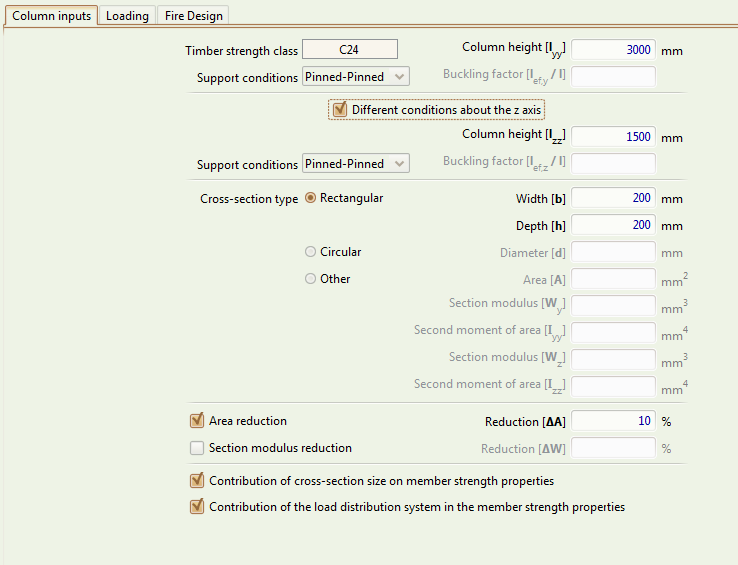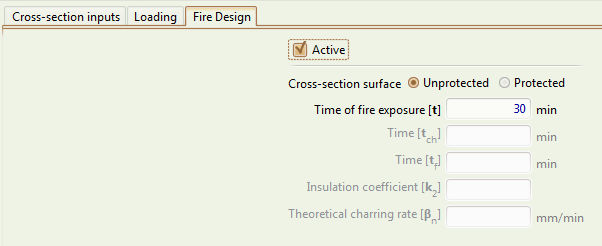Column design
This a column of constant cross-section under combined bending and compression parallel to the grain, taking into account buckling effects, according to Clause 6.3.2.
All references to EN 1995-1-1:2004+A2:2014 unless otherwise stated.
Column Inputs tab

Timber class
The timber strength class of the cross-section. See the timber database page for the types supported by Teretron.
Column height
The length of the column, in mm.
Support conditions
The type of support conditions. Teretron supports the following support conditions for columns:
- Pinned-pinned (pinned on both supports)
- Fully fixed (fully fixed on both supports)
- Fixed-pinned (one support fully fixed, and the other pinned)
- Fixed-free (one support fully fixed, and the other free to rotate and move in all directions)
- Other (covering all other cases).
Factor
For Other support conditions, the user has to select other and enter the relevant effective length factor.
Note that you can change the effective length factors used by Teretron for either the specific column or the entire project via Component > Component Factors or Project > Project Factors respectively.
Different conditions about the z-z axis
This input allows you to provide different support conditions about the z-z axis. This is applicable in cases where the column is restrained laterally at different lengths in each direction.
The column height, support conditions, and buckling factor (if needed) must be input if this box is checked.
Cross-section type
The geometry type of the cross-section.
Width
The width of a rectangular cross-section, in mm.
Depth
The depth of a rectangular cross-section, in mm.
Diameter
The diameter of a circular cross-section, in mm.
Area
The area of a generic cross-section, in .
Second moment of area
The second moment of area of a generic cross-section about the y-y axis, in .
Section modulus
The section modulus of the cross-section about the y-y axis, in .
Second moment of area
The second moment of area of a generic cross-section about the z-z axis, in .
Section modulus
The section modulus of the cross-section about the z-z axis, in .
Area reduction
The area reduction refers to reductions in the nominal cross-section size that have to be taken into account in the calculation of the member strength (e.g. holes from fasteners) according to ### Load duration class
It should be given as a percentage of the total nominal area of the cross-section.
Section modulus reduction
The section modulus reduction refers to reductions in the nominal cross-sectional modulus that are to be taken into account in the calculation of the member strength (e.g. holes from fasteners) according to Subclause 5.2(2).
It should be given as a percentage of the total nominal section modulus of the cross-section.
Contribution of cross-section size on the determination of member strength properties
Includes factors for the calculation of the member strength in solid timber, glulam and LVL, according to Clauses 3.2, 3.3, and 3.4.
Contribution of the load distribution system in the member strength properties
Includes factor for the calculation of the member strength, according to Clause 6.6, for a member that functions as part of a continuous load distribution system.
Note that Subclause 6.6(3) states that the strength verification for a continuous load distribution system should be carried out assuming short-term load duration.
Loading tab

Design compressive force
The design value of the compressive force acting on the cross-section parallel to the grain, in .
Design moment
The design moment about the y-y axis, in .
Design moment
The design moment about the z-z axis, in .
Load duration class
The Load Duration Class, as defined in Clause 2.3.1.2.
Service class
The Service Class, taking into account the temperature and relative humidity of the environment, as described in Clause 2.3.1.3.
Factor taking into account the effect of the duration of the loads and the moisture content, according to Clause 3.1.3.
Fire Design tab

Active
Selects if this cross-section will also be designed against fire.
Cross-section surface
Defines if the cross-section surface is unprotected (exposed to fire on all sides) or is protected (on all sides).
Time of fire exposure t
The time of the exposure of the cross-section to fire, in minutes.
Time
The time of exposure of a protected cross-section to fire until it starts to char, in minutes.
Time
The time of exposure of a protected cross-section to fire until the protection fails completely, in minutes.
Note that this is can be longer (but not shorter) than .
Factor
Factor defines the charring rate of a protected cross-section between the time it starts to char and the time the protection fails completely.
It is required when has a different value to .
Theoretical charring rate
The theoretical charring rate of the timber, in mm per minute.
It is required for plywood where the relevant standards do not provide a default value
Moduli of elasticity in fire design
Allows the user to select if the characteristic or fire design moduli of elasticity will be used in the fire design calculations.